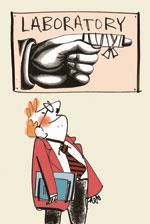Anyone who has any laboratory teaching experience can tell you how difficult it can be to get students to follow instructions
Anyone who has any laboratory teaching experience can tell you how difficult it can be to get students to follow instructions. This is especially true if the student doesn’t actually want to be there, as when medics have to do rotations through the lab. Sometimes not following instructions is only a minor annoyance; after all it’s their degree, not yours. Of course, not following instructions can be downright dangerous: the student who spills phenol across the bench, or who carries a dewar of liquid nitrogen in the failure-prone lift, is risking more than a nasty burn or failed degree.

On the other hand, interpreting instructions creatively, or too literally, can also be a problem. Going beyond the rules, rather than breaking them, has its own risks.
Imagine, if you will, a high school chemistry lab. Today’s experiment is to measure the evolution of hydrogen gas from the reaction of hydrochloric acid with magnesium ribbon. We will be collecting the gas, via rubber tubing, in a graduated 60ml syringe. We will record the volume of gas produced. Knowing what we started with, we can use the ideal gas law to calculate how much hydrogen we should have produced and compare it with what we actually get. The syringes will be clamped so that no one drops them. Most of the class will be using virtually indestructible plastic syringes; the rest will be using these very expensive and fragile new, glass syringes. The plunger moves more freely in these, so we should get a more accurate result.
Quite why Spencer Hogg, the class clown, managed to get one of the new glass syringes was beyond me. Looking back, I suspect it was a deliberate ploy by Mr Woods to keep him interested. It must have worked, because despite Spencer having as much aptitude for chemistry as a homeopathy practitioner, he decided, that fateful day, to take the logical next step and confirm that the product was indeed hydrogen gas. Remembering that the test for hydrogen is the generation of a pop when a lighted splint is held to the mouth of a test tube, Spencer unclamped the syringe, removed the plunger, lit a bunsen and put his lighted splint into the gas-air mixture he had just generated.
To this day I can feel that piece of glass whistle past my ear, while twenty feet away Spencer Hogg stood, pale-faced, holding empty air. That no one was hurt was nothing short of a miracle.
The same was not true for one boy, who thought he was doing exactly as he’d been told. A year after Spencer’s explosive realisation, we did another memorable experiment. We were told to take a certain white powder and heat it in a crucible. Then we were to tip the powder into a watch glass, hold it in the palm of our hand and add water, drop-wise. Finally we had to test the pH and work out what the starting material was.
The white powder was chalk dust, and the first reaction was calcination:
CaCO3 → CaO + CO2
Adding water formed calcium hydroxide:
CaO + H2O → Ca(OH)2
Just as we were all holding the watch glass in our palms in one classroom, there was a scream from the joint top set classroom next door. With unreasonable literal-mindedness and a startling lack of self-preservation, one boy had held the calcium oxide directly in the palm of his hand, sans watch glass. Alkali and an exothermic reaction did the rest.
I watch my students. Very carefully.
Richard Grant












No comments yet